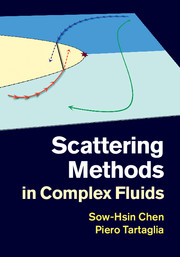2 - Statistical mechanics of the liquid state
from Part I - Scattering and liquids
Published online by Cambridge University Press: 05 May 2015
Summary
In this chapter, we describe the elements of liquid theory. Our intention is not to present all aspects of liquid theory in its complete form, but instead only those that will be useful and sufficient for discussing its different applications for presentations in subsequent chapters. It will be addressed in the context of understanding problems that arise in complex fluids and colloidal science discussed in subsequent chapters.
In Section 2.1 we introduce the concept of the pair correlation function and the structure factor which are fundamental quantities when discussing applications of liquid theories to the analysis of scattering data, including light scattering, X-ray scattering and neutron scattering. We would like to remind the reader here that the pair correlation function and thus the structure factor are intimately connected with the statistical thermodynamics of the system. In this sense the study of the structure factor in the liquid state using scattering techniques is to investigate some aspect of the thermodynamics of the liquid system.
Then we discuss the solution of Ornstein–Zernike equation in its different approximations. In particular, in Section 2.2.3, we illustrate the use of the Baxter method, an elegant analytical method for solving hard-sphere and adhesive hardsphere systems in the Percus–Yevick approximation. These two systems are the model systems for simple liquids as well as for the colloidal solutions. In Section 2.2.4 we present an analytical solution for the case of a narrow-squarewell potential that avoids some aspects of the unphysical features of the Baxter solution of the adhesive hard-sphere system. We shall show in a later chapter the applications of this analytical solution for studying the kinetic glass transition in a micellar system.
We then skip the background introduction to the liquid theories of ionic solutions such as the classical Debye–Hückel theory and the Poisson–Boltzmann theory of ionic solutions, as well as the mean spherical approximation solutions of the so-called primitive model of ionic solution already available in Blum (1980).
- Type
- Chapter
- Information
- Scattering Methods in Complex Fluids , pp. 48 - 87Publisher: Cambridge University PressPrint publication year: 2015



